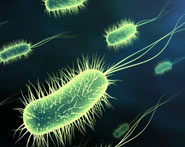


 النبات
النبات
 الحيوان
الحيوان
 الأحياء المجهرية
الأحياء المجهرية
 علم الأمراض
علم الأمراض
 التقانة الإحيائية
التقانة الإحيائية
 التقنية الحيوية المكروبية
التقنية الحيوية المكروبية
 التقنية الحياتية النانوية
التقنية الحياتية النانوية
 علم الأجنة
علم الأجنة
 الأحياء الجزيئي
الأحياء الجزيئي
 علم وظائف الأعضاء
علم وظائف الأعضاء
 الغدد
الغدد
 المضادات الحيوية
المضادات الحيوية|
Read More
Date: 11-6-2021
Date: 3-12-2015
Date: 11-6-2021
|
A-DNA
A-DNA was first recognized as a DNA structure using fiber X-ray diffraction analysis. B-DNA can be converted to A-DNA under conditions of low hydration, and the process is reversible. The A-DNA double helix is short and fat, with the base pairs and backbone wrapped farther away from the helix axis (see Fig. 2 of DNA Structure). The base pairs are significantly tilted (~19°) with respect to the helix axis. The major groove has a very narrow width of ~3 Å and a depth of ~13 Å, whereas the minor groove has a broad width of 11 Å and a shallow depth of 3 Å. The base pairs also display a minor propeller twist.
There is increasing evidence that A-DNA may play an important role in biological processes such as protein recognition and transcription regulation, as in the TATA-box sequence bound with the TATA-box binding proteins (1, 2). There is a sequence-dependent propensity to form A-DNA. Guanine-rich regions readily form A-DNA, whereas stretches of adenine resist it. The crystal structures of DNA oligonucleotides having guanine-rich sequences showed a characteristic intrastrand guanine–guanine stacking interaction in the A-DNA double helix, which may explain the propensity of these sequences to adopt the A-DNA conformation. Moreover, the packing of the helices in the crystal lattice revealed a characteristic pattern of the terminal base pairs from one helix abutting the minor groove surface of the neighboring helix, thus minimizing the accessibility of solvent to the wide minor groove. Since a low humidity environment favors formation of A-type helix, the displacement of surface solvent molecules by hydrophobic base pairs provides a driving force in stabilizing short oligonucleotides in the A-DNA conformation. Recently, it has been demonstrated that complex ions such as spermine, cobalt(III)hexamine, and neomycin can facilitate the B-DNA to A-DNA transition for DNA containing stretches of (dG)n · (dC)n sequences.
Finally, the crystal structures of a number of DNA:RNA hybrids, such as the self-complementary r (GCG)d(TATACGC), showed that DNA–RNA hybrid helices are of the A-DNA type. All the ribose and 2′-deoxyribose sugars are in the C3′-endo conformation. The 2′-hydroxyl groups of the ribose are involved in different types of hydrogen bonding to the adjacent nucleotides in the chain.
References
1. J. L. Kim, D. B. Nikolov, and S. K. Burley (1993) Nature 365, 520–527.
2. Y. Kim, J. H. Geiger, S. Hahn, and P. B. Sigler (1993) Nature 365, 512–520.



|
|
|
|
كل ما تود معرفته عن أهم فيتامين لسلامة الدماغ والأعصاب
|
|
|
|
|
|
|
ماذا سيحصل للأرض إذا تغير شكل نواتها؟
|
|
|
|
|
|
|
جامعة الكفيل تناقش تحضيراتها لإطلاق مؤتمرها العلمي الدولي السادس
|
|
|